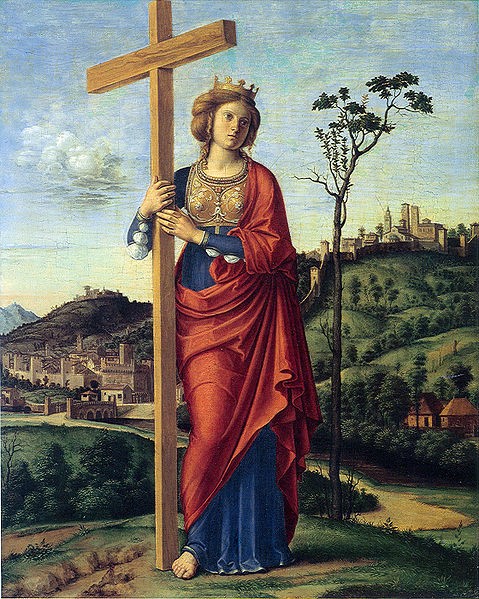This is a legend unlike any other. It all started with a young servant girl named Flavia Julia Helena.1 Born in 248 C.E. in Bithynia, a province of the Roman Empire, Helena was no different from anyone else, until the day that she caught the eye of the Roman emperor Constantius I Chlorus with her beauty.2
They married, had a son in the year 272 who, if you have ever learned anything about Roman history, you will probably know. Their son was the one and only Constantine. Constantine became one of the greatest Roman emperors. One of the things he is known for is the Edict of Milan, issued in the year 313.3 The Edict of Milan allowed for Christianity to be a freely practiced religion. It was at this time that Helena most likely converted to Christianity.4

In the year 324, Constantine sent Helena on a pilgrimage to the Holy Lands in search of the “Holy Sepulcher” and “The True Cross.” The “Holy Sepulcher” is the location of the crucifixion of Jesus Christ, while “The True Cross” is the cross on which Jesus Christ was crucified.5 On this pilgrimage, it was said that Helena “followed in the footsteps of Jesus,” by performing many acts of kindness and good works, such as giving money, food, and clothing to the poor, and also helping churches with funds as well as their other needs.6 After weeks of traveling, they finally made it to Jerusalem. With the help Judas Cyriancus, a man selected at random and forced against his will to help, Helena was able to get closer than she ever had to finding “The True Cross.”7 This is where the story diverges. Although some believe a commoner from a nearby town led Helena to “The True Cross,”others believe that it was Judas Cyriancus.
They continued their search for days, when their prayers were finally answered. Helena said it was then, “With sweet smelling dust and a flash of lighting pointed to the place where,” she instructed Judas to started digging.8 Finally, they uncovered three crosses, one thought to belong to Jesus Christ, and the others belonging to the two thieves that died alongside Him. To test and see which one of these crosses truly belonged to Jesus Christ, they searched for a leper at the outskirts of Jerusalem. Once one was found, they returned back to the site of Golgotha, the place of Jesus’ crucifixion. The leper was instructed to touch each of the crosses one by one. He touched the first one and nothing happened. He touched the second one and still nothing happened. Finally, when he touched the third and final cross, the leper was instantly healed.9 It was this cross that healed the leper, and for that reason it is known as the “The True Cross.”

The cross was then carried back to Constantinople, while part of the cross was placed in the hands of the bishop of Jerusalem.10 As the years passed, fragments of “The True Cross” were placed in the care of many Catholic churches around the world for all to admire. Although we may never know whether the cross they found and distributed was “The True Cross,” like all legends, in the end it is up to us whether to believe the account or not.
- Dictionary of World Biography, 2016 s.v. “Helena, St.” ↵
- Global Events: Milestone Events Throughout History, 2014, s.v. “Saint Helena Makes a Pilgrimage to the Holy Land,” by Jennifer Stock. ↵
- Global Events: Milestone Events Throughout History, 2014, s.v. “Saint Helena Makes a Pilgrimage to the Holy Land,” by Jennifer Stock. ↵
- Dictionary of World Biography, 2016 s.v. “Helena, St.” ↵
- New Catholic Encyclopedia, 2003 s.v. “Helena, St,” by J. H. Geiger. ↵
- Global Events: Milestone Events Throughout History, 2014, s.v. “Saint Helena Makes a Pilgrimage to the Holy Land,” by Jennifer Stock. ↵
- Barbara Baert, “New Observations on the Genesis of Girona (1050-1100). The Iconography of the Legend of the True Cross,” Gesta 38, no. 2 (1999): 117-121. ↵
- Barbara Baert, “New Observations on the Genesis of Girona (1050-1100). The Iconography of the Legend of the True Cross,” Gesta 38, no. 2 (1999): 117-121. ↵
- Barbara Baert, “New Observations on the Genesis of Girona (1050-1100). The Iconography of the Legend of the True Cross,” Gesta 38, no. 2 (1999): 117-121. ↵
- Religious Celebrations: An Encyclopedia of Holidays, Festivals, Solemn Observances, and Spiritual Commemorations, 2011, s.v. “Elevation of the True Cross (September 14),” by J. Gordon Melton. ↵



56 comments
Andrew Dominguez
This was a very interesting article on a key symbol in the christian religion. Its amazing to see Helena do the same actions as Jesus, such as helping the poor. What i thought was shocking is how they tested to see if it was actually the cross Jesus died on. What i want to know is if these stories actually happened or were a myth passed down from generation to generation.
Arianna Kennet
An interesting story or myth about Catholicism, I would say. This story of St Helena is not one which I have heard of before, nor have I heard of the True Cross. Imagine being able to find the place where Jesus was crucified at, and being able to just see and physically touch his cross, what a feeling. If only the story were true. I like how parts of the cross were distributed around the world to honour its significance.
Jose Figueroa
Myths are always so interesting since, in some instances, there is a chance that it actually happened. Not only birthing one of the greatest Roman emperors but possibly finding the cross Jesus was buried on. She was vital to the main practice of Christianity as her son allowed the practice of the religion. My favorite part was how the cross was possibly distributed for all to honor rather than one church hold onto. The story of the healing of the leper was also excellently told.
Vanessa Tombo
This was a very informative article, prior to reading this article I did not know the story of Helena or about the ” The True Cross”. This article was very well written, which made it very easy to follow. The storyline was well constructed which made the article something more than an encyclopedia about Helen’s life. The story of how the true cross was found and it’s connection to Helena’s life is very significant.
Timothy ODekirk
I did not know about Saint Helena and her story. It would be nice to know when her feast day was, but other than that, an absolute great and fascinating article. I love the adventure of this story. I also loved how the leper who was instructed to touch the True Cross was instally healed. If that’s not considered a miracle, then I don’t know what is. This was an interesting story about an absolute historic saint.
Luis Morales
Wow! It amazes me that there are numerous mysteries within the Catholic religion that many people do not know about. I have never heard of this legend before. It is incredible to imagine being able see the site at which Jesus gave his life for us. It’s amazing to see how St. Helena was able to determine which cross was the True Cross Christ had been dead for almost 300 years but yet his legacy lived on. I also find it extremely fascinating that fragments of this cross are spread around the world in different churches.
Kayla Lopez
I have never heard of this legend before so it really caught my attention and made me want to read the whole article. After reading about how pieces of the, “True Cross” have been placed in many Catholic churches around the world in order for those believing to go admire, I really want to believe in this legend for myself. This was a very intriguing article to read.
Iris Henderson
St Helena’s journey for the True Cross was a great read. I did not know that the cross Jesus was crucified on was found or that we had a piece here in Detroit, Michigan. I think that the healing powers may be up to what someone believes in but it would be awesome if we had something that could heal the sick instantaneously like the cross did for the leper.
Joshua Castro
This was an all around fascinating article. It is amazing to see how there are numerous mysteries within the Catholic religion. I was not aware that St. Helena followed Jesus’ footsteps by performing many generous acts while on her pilgrimage to the True Cross. It’s amazing to see how she determined which cross was the True Cross! I also find it extremely fascinating that fragments of this cross are spread around the world in different churches.
Edgar Ramon
I had no idea that we had a piece of the ‘True Cross’ here in the U.S. I had read of this story before, whether it is true or not I obviously do not know, but not too much time had passed since Jesus’ death, and a great many people would look for these relics that Jesus left for centuries to come for some reason. I know that using relics is not a popular practice in current times, but I know that my mother was able to give birth to my youngest sister, when all the doctors told her she was going to die at birth or not last through five years of age. She had been visited by a Franciscan priest earlier, who gave her a piece of cloth from a soon to be beatified person, and she prayed for hours while holding it. I know it’s hard to believe, but the odds were against her. Oh and my sister is completely healthy, and extremely smart.